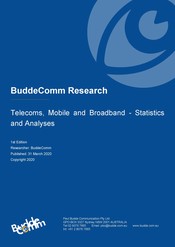2009 Australia - Broadband Market - Overview and Statistics

Last updated: 20 May 2009 Update History
Report Status: Archived
Report Pages: 137
Analyst: Paul Budde
Publication Overview
Researchers:- Paul Budde, Dominic Herbert
Current publication date:- May 2009 (8th Edition)
Next publication date:- May 2010
Executive Summary
The report reveals the proposal from the government to invest $43 billion in a national Fibre to the Home broadband network is a clear indication that they believe broadband infrastructure is a collective good. With its trans-sector multiplier effect it delivers massive social and economic benefits. The second major component of the proposals relates to reform of the regulatory regime for the telecommunications industry. These reforms aim to improve competition, strengthen consumer safeguards and reduce bureaucratic overheads imposed by the state industry regulator. Crucially the reform may include measures to address Telstra’s vertical and horizontal integration, such as functional separation or limitations to the cross-ownership of fixed-line and cable networks and media assets
A trans-sector approach is required to guide us through the development of the NBN. It is critical to look across a variety of industry sectors to create synergy. There are significant opportunities to utilise new telecoms networks for e-health, e-education and smart grids.
With respect to broadband infrastructure,
Network operators currently utilise the copper access network to provide DSL based broadband services and the HFC cable network to provide similar products. While the government plans for a wholesale based national broadband network may change fundamental aspects of the telecoms industry in
Though there are roughly 200 ISPs in
Of critical importance to ISP’s is whether to further invest in DSLAM infrastructure as the fibre optic based national broadband network is built. Further investment will enable ISP’s to directly connect subscribers to their network rather than relying on purchasing wholesale services. However in the longer term the national broadband network may render this investment obsolete as subscribers are migrated to the fibre network.
There are two HFC network operators in
With respect to municipality broadband, councils and communities are beginning to understand the social and economic benefits that broadband can bring to their communities. It is therefore of critical importance that cities are taking charge of the development of their knowledge-based environments. A proactive local government is a vital element in the development of broadband, to the point where it can begin to deliver community benefits in terms of education, healthcare, community services and job creation.
The statistical sections of this report provide broadband statistics relating to the number of subscribers and market shares of major providers as well as additional data relating to DSL, cable and other broadband technologies. Of particular note is that the wireless broadband market is currently booming and this trend is expected to continue into 2010.
In 2008 fixed broadband access among Internet household in
The business market has been quick to embrace broadband – by 2009 the vast majority of the business sector had made the transition. Further growth is expected moving into 2010 despite difficult economic conditions in
In 2008 business broadband usage increased by 143% from just over six million gigabytes downloaded in December 2007 to over fifteen million gigabytes downloaded in December 2008. Over the same period household usage grew by only 24% to 66 million gigabytes.
However business users have been earlier adopters of several broadband media services and in 2009, despite difficult economic conditions, household users may increasingly take up similar services, most notably, IPTV. However pricing of broadband media services is critical for household users. As such the emergence of an economically attractive revenue model based on advertising or other forms is critical.
Data in this report is the latest available at the time of preparation and may not be for the current year.
The following notes provide some background to our scenario forecasting methodology:
· This report includes what we term scenario forecasts. By describing long-range scenarios we identify a band within which we expect market growth to occur. The associated text describes what we see as the most likely growth trend within this band.
· The projections shown in the tables in this report are based on our own historical information, as well as on telecommunication sector statistics from official and non-official, national and international sources. We assume a possible deviation of 15-20% around this data.
· All statistics for GDP, revenue, etc are shown in US$, in order to maintain consistency within and between markets. At the same time we acknowledge that this can introduce some irregularities.
Related Reports
- Australia - Telecoms, Mobile and Broadband - Statistics and Analyses
- Australia - Data Centre Market
- South Pacific Islands - Telecoms, Mobile and Broadband - Statistics and Analyses
- Samoa - Telecoms, Mobile and Broadband - Statistics and Analyses
- Papua New Guinea - Telecoms, Mobile and Broadband - Statistics and Analyses
- New Zealand - Telecoms, Mobile and Broadband - Statistics and Analyses
- French Polynesia - Telecoms, Mobile and Broadband - Statistics and Analyses
- New Caledonia - Telecoms, Mobile and Broadband - Statistics and Analyses
- Vanuatu - Telecoms, Mobile and Broadband - Statistics and Analyses
Share this Report
TMT Intelligence
A platform to scale your intelligence tasks
Monitor critical insights with our AI-powered Market Intelligence Platform gathering and analyzing intelligence in real time. With AI trained to spot emerging trends and detect new strategic opportunities, our clients use TMT Intelligence to accelerate their growth.
If you want to know more about it, please see:
Research Methodology
BuddeComm's strategic business reports contain a combination of both primary and secondary research statistics, analyses written by our senior analysts supported by a network of experts, industry contacts and researchers from around the world as well as our own scenario forecasts.
For more details, please see:
More than 4,000 customers from 140 countries utilise BuddeComm Research
Are you interested in BuddeComm's Custom Research Service?
Hot Topics
News & Views
Have the latest telecommunications industry news delivered to your inbox by subscribing to BuddeComm's weekly newsletter.